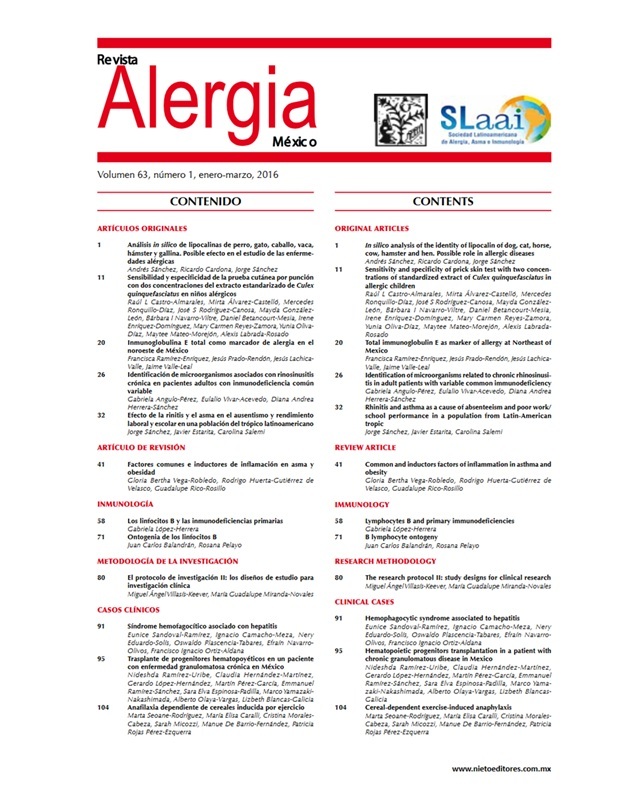Abstract
Background: Lipocalins seem to explain the cross-reactivity between some pets like cat and dog. However, little has been studied its role in other animals and its possible clinical impact in allergy diseases.
Objective: Analyzed by bioinformatics techniques, the identity between lipocalin of some animals and explore the clinical impact in allergic diseases.
Methods: The search for lipocalin sequences was performed using the BLAST program of NCBI Database. The protein sequences were aligned with CLUSTAL Omega UniProt version 1.2.1 software. The base sequence for alignments were lipocalins dogs and cats. The defined percentage identity was compared with the frequency of sensitization to animals exposed in a population of 288 patients with suspected allergic diseases.
Results: Identities between sequences were 10% to 70%. The highest values were found with Can f 6 - Fel d 4 (68%) and Fel d 4 - Equ c 1 (68%). The lower identitiy was found with lipocalin porpurin and retinol binding (<20%). We observed a relationship between sensitization and the percent identity between the species studied.
Conclusions: In conclusion, lipocalins as Can f 6, Fel de 4 and Equ c 1 seem to play an important role in the cross-reactivity to cat, horse and dog but not for the co-sensitization to hamster, cow or birds. Fel de 4 and Equ c 1 could be a prevalent allergen for horse and cat. These results come from predictive analysis and must be confirmed by in vitro and in vivo studies.References
Dennis RJ, Caraballo L, García E, Rojas MX, et al. Prevalence of asthma and other allergic conditions in Colombia 2009-2010: a cross-sectional study. BMC Pulm Med 2012;12:17.
Macías Weinmann A, Escamilla Weinmann C, Pazos Salazar NG, Valdés Burnes DA, González Díaz SN. [Sensitivity to animals’ allergens in people working with animals]. Rev Alerg Mex 2010;57:185-189.
de Jong AB, Dikkeschei LD, Brand PL. Sensitization patterns to food and inhalant allergens in childhood: a comparison of non-sensitized, monosensitized, and polysensitized children. Pediatr Allergy Immunol 2011;22:166-171.
Burbach G, Heinzerling L, Edenharter G, Bachert C, et al. GA(2)LEN skin test study II: clinical relevance of inhalant allergen sensitizations in Europe. Allergy 2009;64:1507- 1515.
Sánchez J, Diez S, Cardona R. Frecuencia de sensibilización a animales en un área tropical. Rev Alerg Mex 2014;61:81-89.
Brozek JL, Bousquet J, Baena-Cagnani CE, Bonini S, et al. Allergic Rhinitis and its Impact on Asthma (ARIA) guidelines: 2010 revision. J Allergy Clin Immunol 2010;126:466-476.
Santos MS, Alves MR, Freitas D, Sousa LB, et al. Ocular allergy Latin American consensus. Arq Bras Oftalmol 2011;74:452-456.
Hanifin JM. Diagnostic criteria for atopic dermatitis: consider the context. Arch Dermatol 1999;135:1551.
Heinzerling LM, Burbach GJ, Edenharter G, Bachert C, et al. GA(2)LEN skin test study I: GA(2)LEN harmonization of skin prick testing: novel sensitization patterns for inhalant allergens in Europe. Allergy 2009;64:1498-1506.
De Knop KJ, Verweij MM, Grimmelikhuijsen M, Philipse E, et al. Age-related sensitization profiles for hazelnut (Corylus avellana) in a birch-endemic region. Pediatr Allergy Immunol 2011;22(1 Pt 2):e139-49.
Matricardi PM, Bockelbrink A, Beyer K, Keil T, et al. Primary versus secondary immunoglobulin E sensitization to soy and wheat in the Multi-Centre Allergy Study cohort. Clin Exp Allergy 2008;38:493-500.
Liccardi G, Salzillo A, Piccolo A, D’Amato G. Skin prick test to horse should be included in the standard panel for the diagnosis of respiratory allergy. J Investig Allergol Clin Immunol 2010;20:93-94.
Borres MP, Ebisawa M, Eigenmann PA. Use of allergen components begins a new era in pediatric allergology. Pediatr Allergy Immunol 2011;22:454-461.
Hilger C, Kuehn A, Hentges F. Animal lipocalin allergens. Curr Allergy Asthma Rep 2012;12:438-447.
Nilsson OB, Binnmyr J, Zoltowska A, Saarne T, et al. Characterization of the dog lipocalin allergen Can f 6: the role in cross-reactivity with cat and horse. Allergy 2012;67:751-757.
Torres JA, de Las Heras M, Maroto AS, Vivanco F, et al. Molecular and immunological characterization of the first allergenic lipocalin in hamster: the major allergen from Siberian hamster (Phodopus sungorus). J Biol Chem 2014;289:23382-23388.
Chapman JA, Williams S. Aeroallergens of the southeast Missouri area: a report of skin test frequencies and air sampling data. Ann Allergy 1984;52:411-418.
Linna O, Niinimäki A, Mäkinen-Kiljunen S. Immunologic cross-reactivity between hen’s feather and house-dustmite allergen extracts. Allergy 1994;49:795-796.
Kemp TJ, Siebers RW, Fishwick D, O’Grady GB, et al. House dust mite allergen in pillows. BMJ 1996;313:916.
Colloff MJ, Merrett TG, Merrett J, McSharry C, Boyd G. Feather mites are potentially an important source of allergens for pigeon and budgerigar keepers. Clin Exp Allergy 1997;27:60-67.
Kilpiö K, Mäkinen-Kiljunen S, Haahtela T, Hannuksela M. Allergy to feathers. Allergy 1998;53:159-164. 22. Sanchez J, Diez S, Cardona R. Sensibilización a aeroalergenos en pacientes alérgicos de Medellín, Colombia. Rev Alerg Méx 2012;59:139-147.
Sanchez J, Diez S, Cardona R. Sensibilización a aeroalergenos en pacientes alérgicos de Medellín, Colombia. Rev Alerg Méx 2012;59:139-147.

This work is licensed under a Creative Commons Attribution-NonCommercial 4.0 International License.
Copyright (c) 2016 Revista Alergia México

